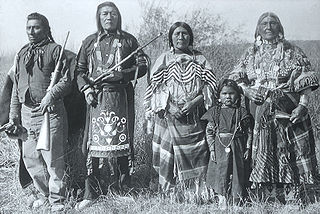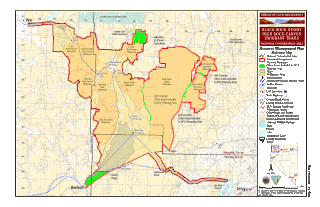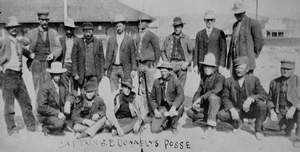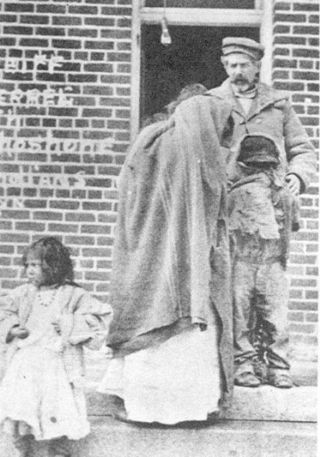
Mike Daggett, original Shoshoni name Ondongarte [1] (died February 25, 1911), was a Shoshone man who is best known for his involvement in the Battle of Kelley Creek, during which he was killed with several members of his family. [2]

Mike Daggett, original Shoshoni name Ondongarte [1] (died February 25, 1911), was a Shoshone man who is best known for his involvement in the Battle of Kelley Creek, during which he was killed with several members of his family. [2]
Daggett was also known by many other names, including "Shoshone Mike" after his death, [3] "Indian Mike," "Rock Creek Mike," and "Salmon River Mike." [4]
![Sheriff Charles Ferrel with surviving members of Mike Daggett's family (Dagget's daughter Heney (Louise, 17), and two of his grandchildren, Hattie (Harriet Mosho, 4))(left) and Cleveland (Mosho, 8)[right] Charles Ferrel and survivors Battle of Kelley Creek.jpg](http://upload.wikimedia.org/wikipedia/commons/thumb/1/15/Charles_Ferrel_and_survivors_Battle_of_Kelley_Creek.jpg/220px-Charles_Ferrel_and_survivors_Battle_of_Kelley_Creek.jpg)
Daggett was the father of 12 to 13 children. The earliest known written record of him was in 1890 when he and his family were removed from their lands on Fort Hall Indian Reservation in Idaho by settlers who claimed they had purchased the land. In the spring of 1910, Daggett led his family off the reservation and they traveled to Nevada and California where they worked at various jobs.
In January 1911, the Daggetts were encamped in Little High Rock Canyon in Washoe County, Nevada. Their winter stores were running low so Mike decided to steal and slaughter some cattle belonging to a local rancher.

The theft did not go unnoticed and a posse of four men went to the canyon to deal with the situation, but when the four entered, Mike and two of his oldest sons ambushed the posse and killed all of them on January 19. The bodies were later found mutilated and piled in a creek bed [5] by a search party on February 8, after which a posse of Nevada and California policemen and citizens was sent to apprehend the Daggett party. On February 25, 1911, the posse discovered Mike Daggett and his followers at a place known as Kelley Creek in Humboldt County, Nevada. During a battle that lasted three hours, Mike was killed, along with seven others.
Four of Daggett's children were taken into police custody. They later attended Stewart Indian School near Carson City, Nevada, but three died because of illness. By 1913 only one, Daggett's baby granddaughter, was still alive, renamed Mary Jo Estep. [4] [6] [7] She died in 1992. [3]
The remains of the dead were buried near Golconda, Nevada.
A March 3, 1919 letter from William Kent to Charles Doolittle Walcott discusses the skull of Mike Daggett stating: "I considered Big Mike's skull as a good game trophy, and therefore had it dug up and sent on. It will be deposited in New Haven." Kent was a member of the Skull and Bones secret student society at Yale University in New Haven. The second part of the letter is likely authored by Aleš Hrdlička and describes the Battle of Kelley Creek.
Eventually, the remains were donated by a local rancher to the Smithsonian Institution. In 1994 the remains were repatriated to the Fort Hall Idaho Shoshone-Bannock Tribe. [8]

Washoe County is a county in the U.S. state of Nevada. As of the 2020 census, the population was 486,492, making it Nevada's second-most populous county. Its county seat is Reno. Washoe County is included in the Reno, NV Metropolitan Statistical Area.

Humboldt County is a county in the U.S. state of Nevada. As of the 2020 Census, the population was 17,285. It is a largely rural county that is sparsely populated with the only major city being Winnemucca which has a population of 8,431. Humboldt County comprises the Winnemucca, NV Micropolitan Statistical Area and serves as an important crossroads in the national transportation network. Interstate 80 travels through the southeastern corner of the county, meeting US 95 in Winnemucca that serves as a primary freight corridor between Northern Nevada and Boise, Idaho and the Interstate 84 freight corridor that links much of the Pacific Northwest. The original transcontinental railway, constructed by the Central Pacific Railroad, reached Humboldt County on September 16, 1868. The Western Pacific Railroad would reach Humboldt County by November 1909, providing two mainline rail links to California and the Eastern United States. Both railroads have since been acquired by the Union Pacific Railroad, who continues to serve the region today.

The American Indian Wars, also known as the American Frontier Wars, and the Indian Wars, was a conflict initially fought by European colonial empires, the United States, and briefly the Confederate States of America and Republic of Texas against various American Indian tribes in North America. These conflicts occurred from the time of the earliest colonial settlements in the 17th century until the end of the 19th century. The various wars resulted from a wide variety of factors, the most common being the desire of settlers and governments for Indian tribes' lands. The European powers and their colonies enlisted allied Indian tribes to help them conduct warfare against each other's colonial settlements. After the American Revolution, many conflicts were local to specific states or regions and frequently involved disputes over land use; some entailed cycles of violent reprisal.

The Bear River Massacre, or the Engagement on the Bear River, or the Battle of Bear River, or Massacre at Boa Ogoi, took place in present-day Franklin County, Idaho, on January 29, 1863. After years of skirmishes and food raids on farms and ranches, the United States Army attacked a Shoshone encampment gathered at the confluence of the Bear River and Battle Creek in what was then southeastern Washington Territory, near the present-day city of Preston. Colonel Patrick Edward Connor led a detachment of California Volunteers as part of the Bear River Expedition against Shoshone tribal chief Bear Hunter. Hundreds of Shoshone men, women, and children were killed near their lodges; the number of Shoshone victims reported by local settlers was higher than that reported by soldiers.
The Shoshone or Shoshoni are a Native American tribe with four large cultural/linguistic divisions:

The Goshutes are a tribe of Western Shoshone Native Americans. There are two federally recognized Goshute tribes today:

The Indigenous peoples of the Great Basin are Native Americans of the northern Great Basin, Snake River Plain, and upper Colorado River basin. The "Great Basin" is a cultural classification of indigenous peoples of the Americas and a cultural region located between the Rocky Mountains and the Sierra Nevada, in what is now Nevada, and parts of Oregon, California, Idaho, Wyoming, and Utah. The Great Basin region at the time of European contact was ~400,000 sq mi (1,000,000 km2). There is very little precipitation in the Great Basin area which affects the lifestyles and cultures of the inhabitants.
The Bannock War of 1878 was an armed conflict between the U.S. military and Bannock and Paiute warriors in Idaho and northeastern Oregon from June to August 1878. The Bannock totaled about 600 to 800 in 1870 because of other Shoshone peoples being included with Bannock numbers. They were led by Chief Buffalo Horn, who was killed in action on June 8, 1878. After his death, Chief Egan led the Bannocks. He and some of his warriors were killed in July by a Umatilla party that entered his camp in subterfuge.
The Snake War (1864–1868) was an irregular war fought by the United States of America against the "Snake Indians," the settlers' term for Northern Paiute, Bannock and Western Shoshone bands who lived along the Snake River. Fighting took place in the states of Oregon, Nevada, and California, and in Idaho Territory. Total casualties from both sides of the conflict numbered 1,762 dead, wounded, or captured.
An Indian colony is a Native American settlement associated with an urban area. Although some of them became official Indian reservations, they differ from most reservations in that they are placed where Native Americans could find employment in mainstream American economy. Many were originally formed without federal encouragement or sanction.

The Bannock tribe were originally Northern Paiute but are more culturally affiliated with the Northern Shoshone. They are in the Great Basin classification of Indigenous People. Their traditional lands include northern Nevada, southeastern Oregon, southern Idaho, and western Wyoming. Today they are enrolled in the federally recognized Shoshone-Bannock Tribes of the Fort Hall Reservation of Idaho, located on the Fort Hall Indian Reservation.

Western Shoshone comprise several Shoshone tribes that are indigenous to the Great Basin and have lands identified in the Treaty of Ruby Valley 1863. They resided in Idaho, Nevada, California, and Utah. The tribes are very closely related culturally to the Paiute, Goshute, Bannock, Ute, and Timbisha tribes.

The Reno-Sparks Indian Colony in Nevada was established in the early 1900s by members of related tribes who lived near Reno for work; they became a federally recognized tribe in 1934 after forming a government under the Indian Reorganization Act.

The Spirit Cave mummy is the oldest human mummy found in North America. It was discovered in 1940 in Spirit Cave, 13 miles (21 km) east of Fallon, Nevada, United States, by the husband-and-wife archaeological team of Sydney and Georgia Wheeler. Analysis of the remains showed similarities to North and South American indigenous peoples and in 2016, the remains were repatriated to the Fallon Paiute-Shoshone Tribe of Nevada. The Spirit Cave mummy was one of the first to be dated using accelerated mass spectrometer radiocarbon dating. In turn, its discovery and analysis gave much insight and motivation of further research into the chronology of the western great basin.

The Duck Valley Indian Reservation was established in the 19th century for the federally recognized Shoshone-Paiute Tribe. It is isolated in the high desert of the western United States, and lies on the state line, the 42nd parallel, between Idaho and Nevada.

The Little High Rock Canyon Wilderness is a US Wilderness Area in Nevada under the Bureau of Land Management. It is located south of the High Rock Canyon Wilderness and west of the High Rock Lake Wilderness.

The Battle of Kelley Creek, also known as the Last Massacre, is often considered to be one of the last known massacres carried out between Native Americans and forces of the United States, and was a closing event to occur near the end of the American Indian warfare era. In January 1911 a small band of Shoshones were accused of rustling cattle and then killing four stockmen who went to investigate the dead cattle. A posse of policemen and citizens was sent to track the band, who were found encamped near Winnemucca, Nevada, in a region known as Kelley Creek. A largely one-sided battle ensued on February 25 that ended with the direct deaths of nine people, eight Daggetts and one posse member. At the time the affair was briefly characterized as a Native American revolt, though it is now mostly regarded as a family's attempted escape from law enforcement.

Mary Josephine Estep was a Shoshone child survivor of the Battle of Kelley Creek, "the last massacre" of Native Americans in the United States, in 1911.
LaNada War Jack, also known as LaNada Boyer and LaNada Means, is an American writer and activist. She was the first Native American student admitted to the University of California at Berkeley in 1968. She led the drive to create the Native American Student Organization and became its chair. As a leader of the Third World Strike at UC Berkeley in 1969, she was arrested but succeeded in obtaining approval for the first ethnic studies courses to be included in the university's curricula. A few months later, she became one of the organizers of the Occupation of Alcatraz in 1969. After the occupation, she completed her bachelor's degree at the University of California, Berkeley and went on to study law at Antioch School of Law in Washington, D.C. While in Washington, she participated in the takeover of the Bureau of Indian Affairs office in 1972.